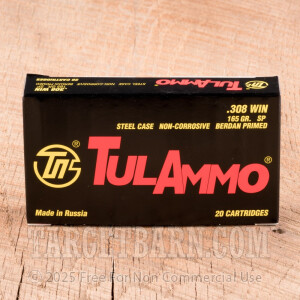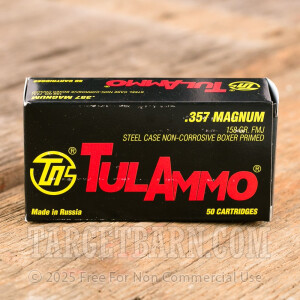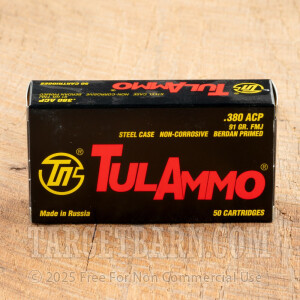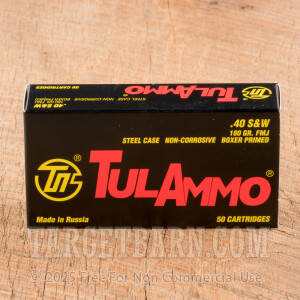

Economical Training Rounds from Russia
Tula, Russia is a guns and ammo town. In 1712 Tsar Peter I founded an arsenal there that would become a major supplier to the Imperial Russian Army. In the fashion of his ancestor, Emperor Alexander II also selected the industrial city when he founded Tula Cartridge Works (Tula) in 1880. Upon its creation, Tula was tasked with producing 210 million rounds of ammunition within seven years. By 1882, it produced more than 30 million cartridges annually.
A Wartime Ammo Producer
More than one quarter of all the ammo used by Russia during WWI was manufactured by Tula. Tula switched from producing brass casings to steel ones in the 1920s, as Russia is rich in iron deposits and the government didn’t wish for ammunition to monopolize their brass reserves. During WWII Tula primarily produced 7.62×54mmR ammo for the ShKAS machine gun, 7.62×25mm Tokarev for the TT semi-automatic pistol, and 7.62×38mmR for the Nagant M1895 revolver. They churned out 400 million rounds annually in their effort to snuff out German advancement!
Modern TulAmmo Production
In 2005, Tula absorbed the Ulyanovsk Cartridge Plant over 500 miles away. The now privately owned enterprise’s output amounts to well over 500 million rounds per year, which comprise 40 types of small arms cartridges. Tula’s C.I.P. and SAAMI compliant ammo supplies Russia’s civilian, law enforcement, and military markets. It is also exported to more than 20 countries across the world, including the U.S. where it is branded as “TulAmmo.”
Tula’s steel shell casings suit their ammunition for budget-minded and high volume shooters. A steel casing generally is not reloadable, causes more carbon fouling of the action, and cycles less efficiently through a semi-automatic weapon. Tula address that third shortcoming with their special polymer coating, which facilitates smooth feeding and extraction and is formulated not to disperse harmful chemicals in reaction to the heat of ignition. That same coating further protects Tula’s casings from rusting and tarnishing during long-term storage.

Tula implements Berdan primers in their steel casings. They are more economical to manufacture, yet they significantly complicate handloading. (That drawback is moot when a Berdan primer is socketed in a steel casing, of course.) Tula once manufactured bi-metal jackets, which are essentially steel on the inside and copper on the outside. Many ranges ban bullets with bi-metal jackets because they tend to penetrate more deeply, which is why Tula ceased importing them to the U.S. as of 2011. Their current U.S. ammunition offers non-ferrous bullets exclusively.
Tula continually invests in technology to better serve Russia and the foreign market. While their drive is to produce economical ammunition, they by no means ignore their products’ quality in the process. For its price tag, Tula ammo offers an attractive balance of value and reliability that makes shooting an accessible hobby to those who must keep the thickness of their wallets in mind.
Tula Cartridge Works on TargetBarn
Tula Ammo Latest Reviews
-
 Tula 308 Winchester Ammunition - 500 Rounds of 165 Grain SPShoots well out of my century c308. Near moa groups from a rest! I have killed several deer with this round, however, bullet expansion is hit and miss. Overall, impressed at this price point.
Tula 308 Winchester Ammunition - 500 Rounds of 165 Grain SPShoots well out of my century c308. Near moa groups from a rest! I have killed several deer with this round, however, bullet expansion is hit and miss. Overall, impressed at this price point.
8/3/2020 -
 Tula 357 Magnum Ammunition - 50 Rounds of 158 Grain FMJI bought 200 rounds of this Tula to run through my Ruger Blackhawk. It shot 2-2.5” groups at 50 yards. No misfires, no problems of any kind. I should have bought a case of it . I’ll buy it again
Tula 357 Magnum Ammunition - 50 Rounds of 158 Grain FMJI bought 200 rounds of this Tula to run through my Ruger Blackhawk. It shot 2-2.5” groups at 50 yards. No misfires, no problems of any kind. I should have bought a case of it . I’ll buy it again
7/28/2020 -

-

-
 Tula 9mm Luger Ammunition - 1000 Rounds of 115 Grain FMJGreat ammo, great price as I do not reload, delivered promptly.
Tula 9mm Luger Ammunition - 1000 Rounds of 115 Grain FMJGreat ammo, great price as I do not reload, delivered promptly.
8/2/2016 -
 Tula 9mm Luger Ammunition - 1000 Rounds of 115 Grain FMJI purchased 1000 rounds of this ammo and they ran through my Beretta 92FS perfectly. Unfortunately our club range officer approached me and asked what kind of ammo I was using. I showed him the cartridge and the box. He inform me that large sparks were coming off the steel backstop, which indicated the ammo was steel jacket or steel core and those are not allowed at the range. . We looked at the box and could not find any evidence of that.I went back to shooting copper clad.When I got home I pulled a bullet out of a case. Sure enough it was strongly attracted to a magnet. I sectioned the bullet and found a relatively hard silver colored jacket and a soft silver core. Since the only common metals that are ferromagnetic are Iron,Cobalt & Nickel I am hard pressed to understand what these bullets of.
Tula 9mm Luger Ammunition - 1000 Rounds of 115 Grain FMJI purchased 1000 rounds of this ammo and they ran through my Beretta 92FS perfectly. Unfortunately our club range officer approached me and asked what kind of ammo I was using. I showed him the cartridge and the box. He inform me that large sparks were coming off the steel backstop, which indicated the ammo was steel jacket or steel core and those are not allowed at the range. . We looked at the box and could not find any evidence of that.I went back to shooting copper clad.When I got home I pulled a bullet out of a case. Sure enough it was strongly attracted to a magnet. I sectioned the bullet and found a relatively hard silver colored jacket and a soft silver core. Since the only common metals that are ferromagnetic are Iron,Cobalt & Nickel I am hard pressed to understand what these bullets of.
7/21/2016 -
 Tula 9mm Luger Ammunition - 1000 Rounds of 115 Grain FMJI'm not a reloader so this ammo is perfect for me
Tula 9mm Luger Ammunition - 1000 Rounds of 115 Grain FMJI'm not a reloader so this ammo is perfect for me
5/31/2016












